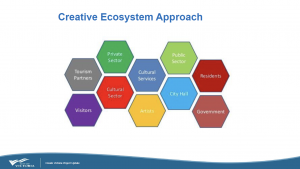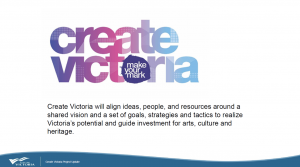Cultural and creative ecosystems
Cultural and creative ecosystems can be thought of as both a metaphor and a framework used to grow and innovate in the creative and cultural sector (Barker, 2018). Though this ecosystem approach is receiving increased attention in the last couple of years, coming to a single definition of the concept has proven difficult. Some suggest that this is due to the wide variety of models being used (Barker, 2018; de Bernard and Comunian, 2021). Several working definitions of cultural and creative ecology have been amassed including Howkins’ (2013) suggestion that creative ecologies are created when communities work together in a systematic, collaborative and adaptive way to produce new ideas and Markussen et al.’s (2011) description of “the complex interdependencies that shape the demand for and production of arts and cultural offerings” (p. 8). With this thinking in mind, we must look at all the aspects that make up a cultural ecosystem and continue to seek out ways to work together as a community.
Exploring the creative ecosystem approach
We invited Nichola Reddington, the Senior Cultural Planner, Arts, Culture and Events Office with City of Victoria, to share some of her strategies and experiences with us regarding the development of the “Create Victoria” plan (See video 3:8 Interview with Nichola Reddington). In our recent conversation, Reddington shares that there is real power in face-to-face meetings in building relationships: “We’ve always tried really hard to host drop-in coffee meetings … sometimes the simplest things that have the biggest impact” (Zoom Interview, July 2021).
Video 3:8, Interview with Nicola Reddington
When it came time for the engagement process for the City’s Cultural Master Plan, “Create Victoria,” she was able to reach out to contacts and relationships she had developed over a 15-year period using her social capital from living and working in the community and attending events to encourage people and organisations to become involved. Some general suggestions she offers include: Hosting an event prior to the Fringe Festival, meeting people where they are, and understanding that not everyone is comfortable coming into City Hall. It is integral to strengthen all relationships and help make everyone feel more comfortable and welcomed.
The City of Victoria has taken a creative ecosystem approach in the development of their “Create Victoria” plan (See figure 3:8 Create Victoria’s creative ecosystem approach).

Reddington further clarifies her tactics: “With the ecological approach, there are basically two modes of inquiry … you can look at systems, or you can look at processes. [For example, with] music strategies, we often look at the value production exchange and look at processes. If you’re a musician and you want to produce an album and … get it to market, you will look at all the steps that someone would need to take and the processes to deliver that project. … If you are looking at a city-wide, integrated cultural plan, the systems approach is really the way to go. … It is really helpful to break it down into those types of systems, rather than looking at it from a [solely] disciplinary approach” (Reddington, Zoom interview, July 2021).
This leads us to the question: How do we create a sustainable city? Reddington talks about how we weave together these networks and groups in our community. Creating the connections and facilitating the interweaving of groups and sectors in our community starts with determining what culture actually is. Those of us who have gone through the cultural master planning process know that you will get a wide variety of definitions. Reddington indicates this is part of the cultural planning 101, getting together at various networking and engagement events to discuss what defines culture in our communities.
A key aspect from the city point of view is to determine what the city’s role is in influencing and enabling culture (See image 3:9 Create Victoria). We go for lots of coffees, building relationships and engaging in conversations, creating those connections (Reddington, Zoom interview, July 2021). It is also important to know when you need to step in and provide support, and also when the municipal structures need to get out of the way (Reddington, Zoom interview, July 2021).

Reddington shares that many people move to Victoria because “it’s seen as a creative place, and there’s a good vibe here” (Zoom interview, July 2021). She advises to continue to communicate to the politicians and planners and decision-makers, to remind them of the reason people relocate to your community. Identify the things that add cultural value to your community such as impromptu concerts on patios, theatres, galleries, engaging public art, festivals, events. Reddington has generously shared some links to the Create Victoria Plan and its supporting documents (See link 3:3 Create Victoria Plan).
